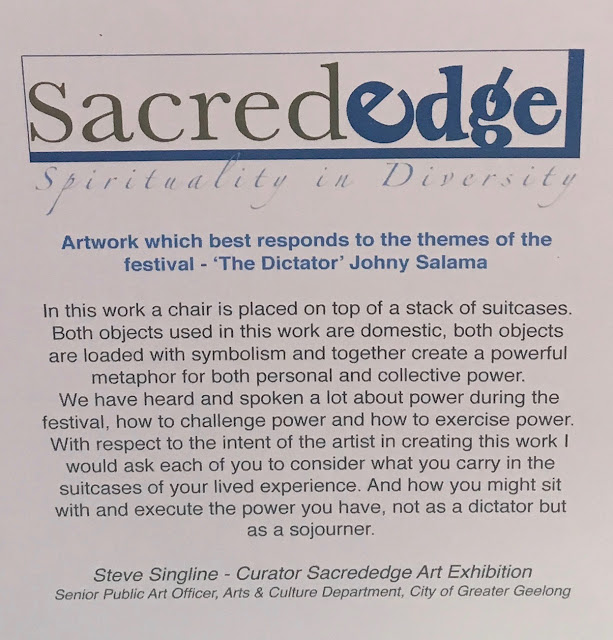PETER DAY
Lake Country (2019)
WINDOWSPACE
June 2019
Peter Day, Lake Country (2019)
Full
or empty the local lakes are joy – Corangamite, Colac and Beeac, each lake has
its distinct character. Lake Colac is the largest natural freshwater lake in
Victoria, blue and alluring on a sky-blue day. Lake Beeac is extremely moody
and saline, yet beside it to the south west is the freshwater Beeac Swamp which
has been known to host families of swans. Lake Corangamite is complex, the
largest permanent saltwater lake in Australia with an area of 23 000 hectares.
These waters, saline and fresh, form part of the RAMSAR wetlands, an area known
as Kanawinka that stretches into South Australia, and as such they are vital to
many flora and fauna and local and migratory birds.
These
are the stamping grounds of the multi-disciplinary 'environmental artist' Peter Day, who has recently worked with the Beeac Primary School on an award-winning project
devoted to the brolga. This association will continue into 2019 as Day again
joins the school to develop a six-season native garden project, Knowledge Garden.
Roaming
and gleaning as he does, it is no surprise that Day names John Wolsley and
Rosalie Gascoigne among favourite visual muses. Wolsey’s work is somehow
a useful tandem to the writing of Bruce Pascoe (Dark Emu, 2014) – each man seeking the crucial elements that tell
the story of the natural world so we may learn how to rejoin it, respect it and
rejoice in it.
In
2010 Wolsey turned his attention from desert to wetlands, his present focus, as
he puts it is to “enact a re-enchantment that
mends the broken relationship between nature and humankind”. Wolsley arrived in
Australia from the UK in 1976 and Australia’s landscape enthralled him,
immediately. His passion is infectious and crucial and very much fired by the example
of the First Australians and the natural micro and macro of this rugged ancient
land. As he recently put it:
My work … has been a search to discover how we
dwell and move within landscape. I have lived and worked all over the continent
from the mountains of Tasmania to the floodplains of Arnhem land. I see
myself as a hybrid mix of artist and scientist; one who tries to relate the
minutiae of the natural world - leaf, feather and beetle wing - to the abstract
dimensions of the earth's dynamic systems. Using techniques of
watercolour, collage, frottage, nature printing and other methods of direct
physical or kinetic contact I am finding ways of collaborating with the actual
plants, birds, trees, rocks and earth of a particular place.
John Wolseley, field notes (2018)
Rosalie Gascoigne,
(1917 – 1999), was an unashamed gleaner – she roamed the hills of her adopted Monaro
countryside, (she was born in New Zealand), and gathered what caught her eye to
create powerful yet simple sculptural assemblages – the response to what she
described as her untutored apprenticeship of ‘50 years of looking’ (she did not
begin exhibiting until she was 57). Gascoigne’s focus on line and form had developed
in the practice of Sogetsu ikebana: ‘Its general
principles of valuing immediate response, the experience of materials, process
and experiment with variations can be seen as underpinning all of her later
work’ (AGNSW notes, https://www.artgallery.nsw.gov.au/collection/artists/gascoigne-rosalie/).
Rosalie Gascoigne, photo Greg Weig
The found
materials she selected always bore the ‘imprint of time in the land’ and this
predilection links her creative urge with that of Wolsey, and in turn Day. No
material was too humble, all had character.
Day appears
fascinated by the most fundamental of materials, natural grit, and its surprising
range of colour, undoubtedly a result of his background in horticulture and
landscape design – practices close to the earth in which he involves ‘collaboration with communities discussing
environmental themes and conservation’.
“Over the years a plethora of ocean washed finds have been transformed into art materials. I spend a lot of time on Victoria’s wild south coast which is basically a catchment for the southern ocean currents.
Peter Day, Windblown, found wood, 2008
“I have watched ocean refuse turn from mainly natural flotsam and wood to flotsam, wood, plastics and nylons. I continue to make sculpture from what I find washed up and inadvertently map the ocean’s unwanted refuse through my artworks.”*
Peter Day, Vessel, found mixed media, 2018
While studying, lecturers Hank Swann, John Patrick and Meredith Drew 'influenced me profoundly' Day observed. It was they who: 'set me on a course of conservation through making'. Out on the landface Day developed his ‘art meets ecology
programs in the Otway Ranges Victoria and the Kimberley WA, while working as an
education officer between 2004 and 2011 out of a need to connect people with
nature'.* To that he has added a
sculptural practice bridging land and art. WINDOWSPACE welcomes Day's focus on the local colour and form of the Lake
Country.
AS
*Artist's notes






